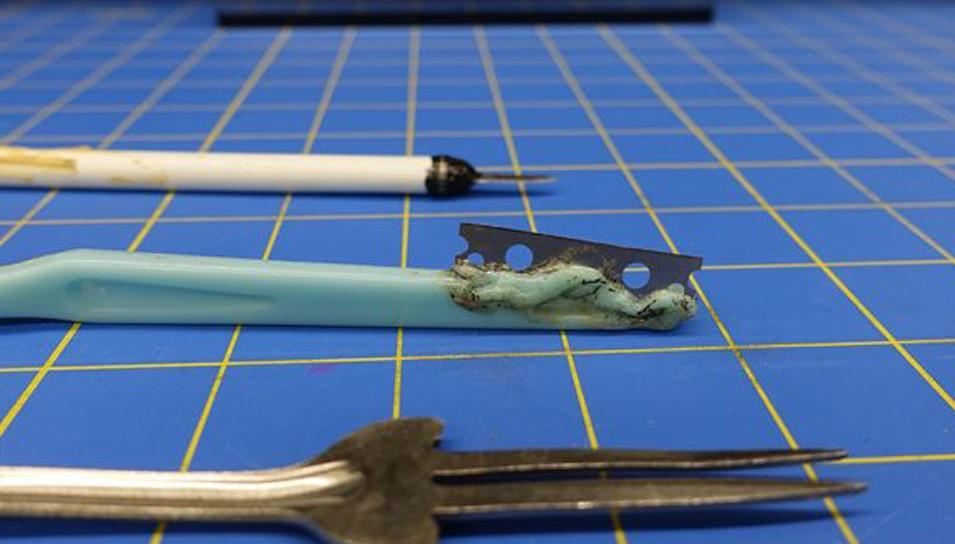Taking Measure
Just a Standard Blog

As I peer into the cardboard box NIST researcher Amanda Forster holds out for me, I can’t help thinking that this mild-mannered materials scientist has an impressive collection of shivs. The handmade prison weapons include a ballpoint pen with a razor embedded in the shaft and a toothbrush—originally designed to be gentle on your gums—that’s been re-engineered to easily puncture flesh. They are vivid evidence of a scary fact of prison life: anything can be turned into a weapon.
Corrections officers wear stab-resistant body armor that’s usually made from fibers of extremely strong material such as Kevlar, just like the ballistic body armor worn by police or military personnel. But because ballistic armor is designed to stop fast-moving bullets and stab-resistant armor is designed to stop objects propelled only by a human arm, they differ in how they are woven.

“Stab-resistant body armor is designed with a much tighter weave than ballistic-resistant body armor,” says Forster. “I like to compare it to when you buy bedsheets and you look for a high thread count so you get a fine fabric. When you have ballistic-resistant armor, it’s a very coarse thread count because you’re basically trying to make a net to stop the bullet. With stab-resistant body armor, the point of the knife will just slide past those threads, so you need a very tight weave—a high thread count.”
Forster and her colleagues are using the confiscated weapons to develop standards for stab-resistant body armor. She shows me the lab where they test the body armor by dropping a standardized sharp object such as a spike, knife, or improvised weapon (like a shiv) down a tube from varying heights onto the armor sample. Beneath the armor they place foam, also standardized, that stands in for the human body.
A very flat human body.
Spend enough time around scientists, and you learn that research can often take an unexpected turn. This was the case when Forster and her coworkers learned about the changing demographics of corrections personnel and their work went in a whole new—and unexpectedly challenging—direction.
“Women are a growing percentage of corrections staff,” says Forster. “And they tend to have more non-planar surfaces than men.” (That’s how scientists say curves.) Women have far fewer models of body armor to choose from, which can leave them less likely to find the right fit.
Body armor tests were designed with the assumption that the armor would be flush against the body. But a woman’s curves mean that there could be gaps, for example at the waist or between the breasts—and that could affect how the material performs.
The NIST researchers realized their flat sheets of foam would have to be modified somehow, or even replaced, to better mimic the potential curves of the female body. So instead of focusing on characterizing the foam’s qualities such as density, their work turned to creating a model, or surrogate, that would help manufacturers test and make body armor designed for women.
“We looked at how we could make a 3-D bust-like structure out of this material, and it was probably the biggest challenge we faced,” says Forster. “We decided we would look at a B cup and a D cup, but it turns out defining what is a B cup and what is a D cup is not very easy.” (As any woman who has shopped for a bra knows.)
Forster found lots of information on clothing design, but nothing that helped her create a suitable substitute for the body to put behind the armor. For example, she found a study of chest circumference, but it didn’t offer any information on how much of that circumference was on the front of the body as opposed to the back.
She even made trips to stores, ruler in hand, to measure different bra sizes. And she and her colleagues worried that some of their Internet searches might look fairly odd to someone not familiar with their project.

Medical literature on breast reconstruction offered insight into volume but relied on more fluid materials, such as silicon. However, that research did point the team toward experimenting with different shapes, such as hemispheres, cones and paraboloids.
Eventually, they defined some 3-D shapes, figured out how to make dies for the foam, then stacked the pieces to form the shapes and approximate the volume.
The research effort resulted in a paper, Specifying and testing idealized bust surrogates for testing of female stab-resistant body armor, that offers guidance on how the foam models might be incorporated into standardized test methods.
“During this project we learned that women represent 37 percent of adult correction personnel and 51 percent of juvenile correction personnel,” says Forster. “And yet there are still few models of body armor for them to choose from. We think this research will definitely help manufacturers figure out how to manufacture and test more designs for women.”
I’ve never needed body armor for my work as a science writer, but I have had the chance to try it on and to hear from women in the military who had few options when it came to size and fit. I’ve also learned that the most important advances can come from researchers’ willingness to adjust to the curves on the road to discovery.
About the author
Related posts
Comments
Depending on the ground caliber 456 ballistic plates or ceramic






Body armour must be body fit and as per body shape.